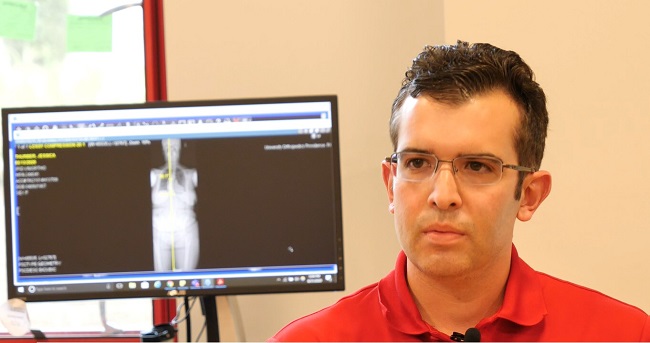
Physical therapist Stephen Cinquegrana of University Orthopedics Inc. recently completed his certification in Schroth therapy, a nonsurgical treatment for scoliosis.
Cinquegrana, the only physical therapist to offer the therapy in Rhode Island, shares a few details about the treatment and how he has used it to help scoliosis patients.
PBN: Please briefly explain what Schroth therapy is – who is it for, and why is it unique?
CINQUEGRANA: Schroth therapy is a method of scoliosis and patient-specific exercise designed to strengthen the muscles of the spine in their best-possible position so that a patient can maintain an optimal posture. The premise of Schroth therapy is that the system of exercises is strengthening and elongating the muscles of the trunk to allow the patient their most optimal posture. The better the patient is able to maintain their ideal posture, the stronger the result is. Ideally, the patient should see a reduction in symptoms, improved respiratory function and a decelerated or stopping of curvature progression.
Schroth therapy is designed for people with scoliosis, hyper-kyphosis (Scheuermann’s kyphosis) and other postural conditions. It is unique in that it is a research-driven method of exercise designed specifically for patients with impairments stemming from their posture.
The type of Schroth therapy that I practice is called “BSPTS (Barcelona Scoliosis Physical Therapy School) Concept by Rigo,” or “Rigo method.”
PBN: Have you had a chance to use the treatment on patients yet?
CINQUEGRANA: Yes, I have been treating patients using this technique for the past three years. My certification process was completed during October of 2019. I treat both children and adults with scoliosis.
PBN: Why did you decide to become certified in Schroth therapy?
CINQUEGRANA: Learning Schroth therapy was a natural evolution of my spine specialist career path. I had recently accepted the spine specialist physical therapist position at University Orthopedics three years ago. I found that while I was able to successfully treat patients with many different conditions, the management of scoliosis proved to be elusive. With the knowledge I had at the time, there was a lack of acceptable results for this patient-population. I was disappointed in the lack of scoliosis content in the Orthopedic Certification Specialty I was pursuing. When the opportunity arose to become certified in a technique that was proven to help patients with scoliosis, it was an easy decision.
PBN: How important is physical therapy for patients with scoliosis?
CINQUEGRANA: Whether the patient is a child facing a progressive scoliosis or an adult that wants the right tools to manage their symptoms, good physical therapy is very important. Maintaining an optimal posture is extremely beneficial to the patient’s quality of life for both emotional and physical reasons.
For children and their families trying to achieve their best outcome facing a progressive scoliosis, whether that is surgery or conservative management, having the proper tools to tackle the situation is very important. Even something as simple as educating a child on proper brace fit can have an enormously positive impact on the conservative management of scoliosis. Schroth therapy helps reduce the risk of progression towards surgery but cannot guarantee that the patient will not progress to surgery – every case is unique. Whether a patient ultimately requires surgery or not, Schroth helps give them their best result.
For adults that are having symptoms related to their posture, Schroth provides effective tools to improve their posture. Often times this leads to a reduction in symptoms and an improvement in the patient’s well-being. There are also times when adults are dealing with a progressive scoliosis that may require surgery. In these cases, a physical therapist can help guide the patient through a difficult decision-making process and provide them with peace of mind.
In both populations, physical therapy after surgery is important in terms of proper recovery. Exercise helps strengthen the trunk to achieve the most optimal result postoperatively.
PBN: What are some other conditions that patients come to you with, and do you have your eye on any other new therapy methods?
CINQUEGRANA: Being a spine specialist, I see patients with many different lumbar, thoracic and cervical conditions. I see everything from garden variety neck or back pain to very complex fusion procedures. A large percentage of my case load is now both children and adults with scoliosis.
As far as new therapy methods go, there are both older and emerging schools of thought I’d like to learn more about. Skilled Functional Movement Assessment fits in nicely with the way I practice. McKenzie therapy is an older school of thought but very relevant these days, especially with emerging research and their importance in the clinical practice guidelines. I would also like to progress further in the BSPTS organization, and a personal goal of mine would be to become an instructor so that the people of Rhode Island can have more therapists that provide effective care for scoliosis.
Elizabeth Graham is a PBN contributing writer.












